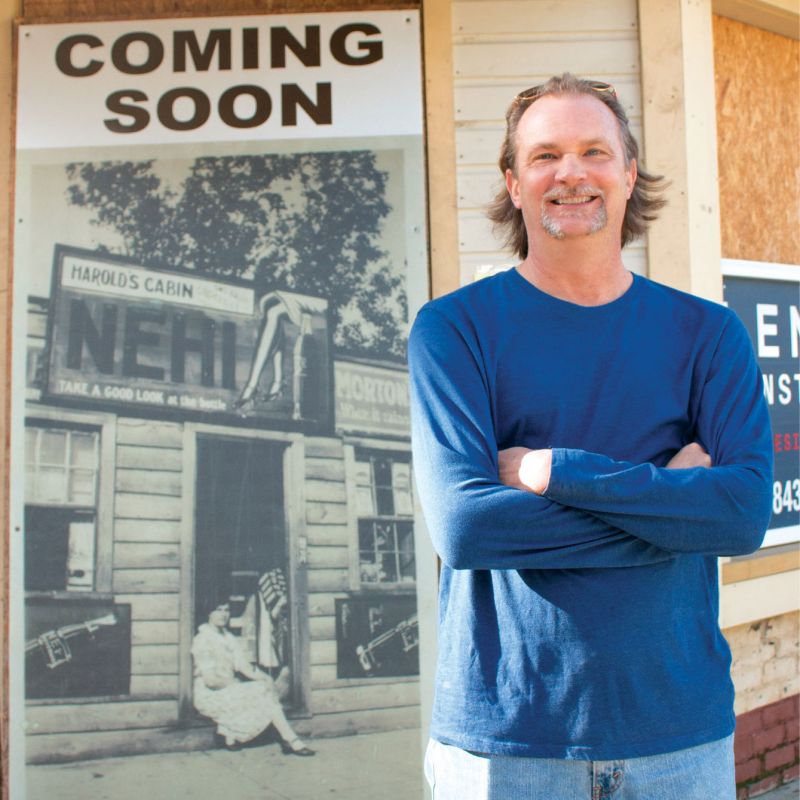
CM: How’d you get interested in reviving Harold’s Cabin?
JS: When I left the restaurant business 15 years ago to work baseball stadiums, I knew I’d return one day—but it just had to be the right place. A couple of years ago, a friend took me by the site and said, “The building’s a rundown piece of crap, but I think there’s a story behind it.” So I started checking it out, and, after some research, I knew it had soul.
CM: So what’s the story?
JS: Back in the ’20s, teenager Harold Jacobs started selling snowballs on the corner of President and Congress. (They’re like snow cones, but fluffier.) Then in the mid-’30s, his parents leased this building behind the original stand and opened up a mercantile with canned goods, produce, and weird knickknacks. Harold took over in the ’40s, and he was ahead of his time: He sold so many specialty gourmet items that Harold’s was almost like a precursor to Dean & Deluca. He was also one of the first in Charleston to carry frozen food. The store relocated to Wentworth Street in the mid-’50s, and by the mid-’70s, he decided to retire and travel with his wife, Lillian.
CM: Did you find any great relics during your research?
JS: There are so many gems. Harold left all of his papers to the Special Collections Department of the College of Charleston, including black-and-white photos. We found one of his mom under a huge Nehi soda sign in front of the store in the mid-’30s. We had it blown up and, while it’s our “Coming Soon” sign now, we plan to hang it inside.
CM: Are there any other ways that your Harold’s Cabin nods to the original?
JS: There’s a small commercial area that’ll sell a hodgepodge of fun and funky stuff (don’t be surprised to see a can of Dapper Dan), a counter for coffee, and grab-and-go meals. People remember getting pickles out of a barrel in the store, so we may bring that back. Harold’s was also known for Savoure cheese, which has poppy seeds and a cream-cheese base, so we may recreate something similar.
Our space will have 30 seats in an elevated area on the first level and another 30 upstairs. It’s a neighborhood business. We want people to ride their bikes, walk, stop in for coffee, read the paper, and be part of this gathering place.
CM: Are we going to see the same type of gluttonous mash-ups you’re known for at The Joe?
JS: If I’m doing what I’m supposed to, yes. But the food will still be approachable. The menu is rustic and produce-centric, but certainly not vegetarian. You might see bison on the menu, and maybe quail. We’ve constructed a rooftop garden for growing herbs, lettuce, roots, and seasonal veggies, with Leslie Wade as our resident gardener. Eventually, we’d like to get some bees up there, too.
CM: Did snowballs make the cut?
JS: They’re the first things we started on. We’ve been working to create natural syrups so they won’t stain tongues or fingers, using real-fruit flavors mixed with herbs from the garden. We’ll serve them to kids, but we’ll have some for adults, too.
CM: How’d you get started in F&B?
JS: I have a pretty eclectic background. At 13, I worked in a peach shed separating the fruit. Then I moved to a dishwasher job, and I’ve held positions in mom-and-pop restaurants, wing joints, the Marriott, and on a traveling team opening Joe’s Crab Shacks. The corporate world wasn’t my scene, but that’s where I learned the nuts and bolts.
CM: Where did you get your love of food?
JS: I grew up in a family with five kids, so my mom cooked for seven people every day. On Sundays, we’d sit down in the formal dining room and try a new recipe that she clipped from The New York Times—some good, some not so good. I think I took on her passion for food adventure.